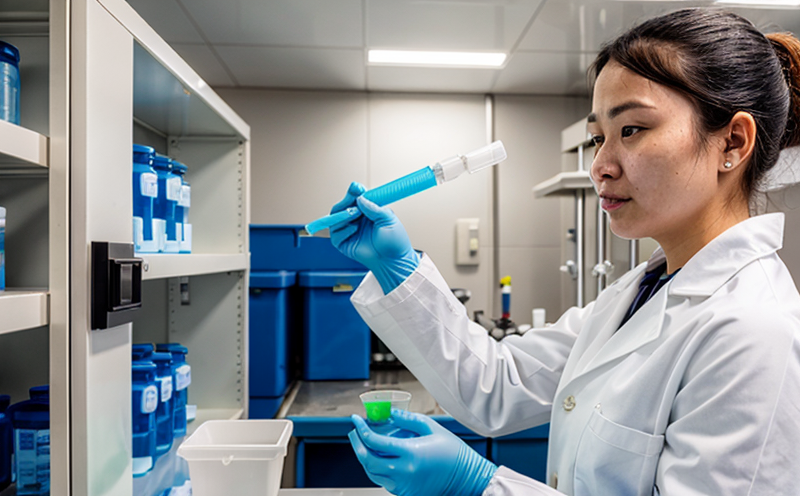USP Fungal Contamination Testing
In the pharmaceutical industry, ensuring product quality and safety is paramount. Among the various tests conducted to meet stringent regulatory standards, USP fungal contamination testing holds a critical role in safeguarding consumer health.
The United States Pharmacopeia (USP) Fungal Contamination Testing is specifically designed to detect and quantify fungi present in pharmaceutical products. This test ensures that medications are free from harmful microbial contaminants which could pose significant risks if introduced into the body. Compliance with USP standards not only enhances product safety but also builds consumer trust.
The testing process involves several key steps, including sampling, preparation of specimens, and analysis using advanced laboratory techniques like culture methods or molecular biology approaches such as PCR (Polymerase Chain Reaction). Culture-based methods involve inoculating samples onto appropriate media that supports fungal growth. This allows for the identification and enumeration of different fungal species.
For more precise detection, laboratories may employ quantitative real-time PCR assays which offer higher specificity and sensitivity compared to traditional culture techniques. These molecular tools can detect minute quantities of DNA or RNA from fungi even in complex matrices such as tablets or capsules.
The acceptance criteria for this test are stringent and follow established guidelines from international standards bodies like USP, ISO, and EU guidelines. Failure to meet these standards can lead to product recalls, which not only affect the company's reputation but also incur substantial financial losses.
In addition to ensuring product safety, USP fungal contamination testing plays a vital role in maintaining compliance with current Good Manufacturing Practices (cGMP). By adhering to cGMP regulations, pharmaceutical manufacturers can demonstrate their commitment to producing high-quality medicines free from microbial contaminants.
The importance of this test extends beyond mere compliance; it reflects a broader responsibility towards public health. Ensuring that no fungi are present in medicinal products reduces the risk of adverse reactions and maintains the integrity of each batch produced by the manufacturer.
In summary, USP fungal contamination testing is an essential step in pharmaceutical quality assurance processes. It helps protect consumers from potentially harmful contaminants while ensuring adherence to regulatory requirements and industry best practices.
Benefits
- Avoids Health Risks: Ensures that pharmaceutical products do not contain harmful fungi, thereby protecting public health.
- Enhances Product Quality: Guarantees consistent and reliable product quality across all batches produced by the manufacturer.
- Facilitates Compliance: Helps companies stay compliant with regulatory standards set forth by organizations like USP, FDA, and EU.
The benefits of adhering to rigorous fungal contamination testing extend beyond just compliance. By implementing this practice, pharmaceutical manufacturers can build a robust reputation for producing safe and effective medicines. This not only fosters consumer confidence but also supports long-term business sustainability.
International Acceptance and Recognition
The USP fungal contamination testing protocol enjoys widespread acceptance and recognition globally due to its robustness and reliability. Regulatory authorities worldwide, including those in Europe (EMA), Japan (Pharmacopoeia of the People's Republic of China), and other regions, often refer to this standard when evaluating pharmaceutical products.
According to ISO 17895:2013, which aligns closely with USP standards, fungal contamination levels must be controlled within specified limits to ensure product safety. Similarly, the European Pharmacopoeia (Pharmacopoeial monographs 4.6) emphasizes the necessity of controlling microbial loads in medicinal products.
Compliance with these international standards is not only a legal requirement but also an indicator of high-quality manufacturing practices. Pharmaceutical companies that adhere to such stringent testing protocols are seen as leaders in their field, setting benchmarks for others to follow.
Environmental and Sustainability Contributions
- Eco-friendly Practices: By ensuring product purity, USP fungal contamination testing minimizes the risk of contaminated waste entering the environment.
- Reduced Waste: Precise testing helps in minimizing overproduction and subsequent disposal of potentially harmful batches.
- Innovation: Continuous advancements in testing methodologies contribute to more efficient resource use throughout the manufacturing process.
The commitment to environmental responsibility is evident through various initiatives undertaken by pharmaceutical laboratories. For instance, reducing the amount of waste generated during production can significantly lower carbon footprints. Additionally, adopting sustainable practices such as recycling and reusing materials further enhances overall ecological impact.





